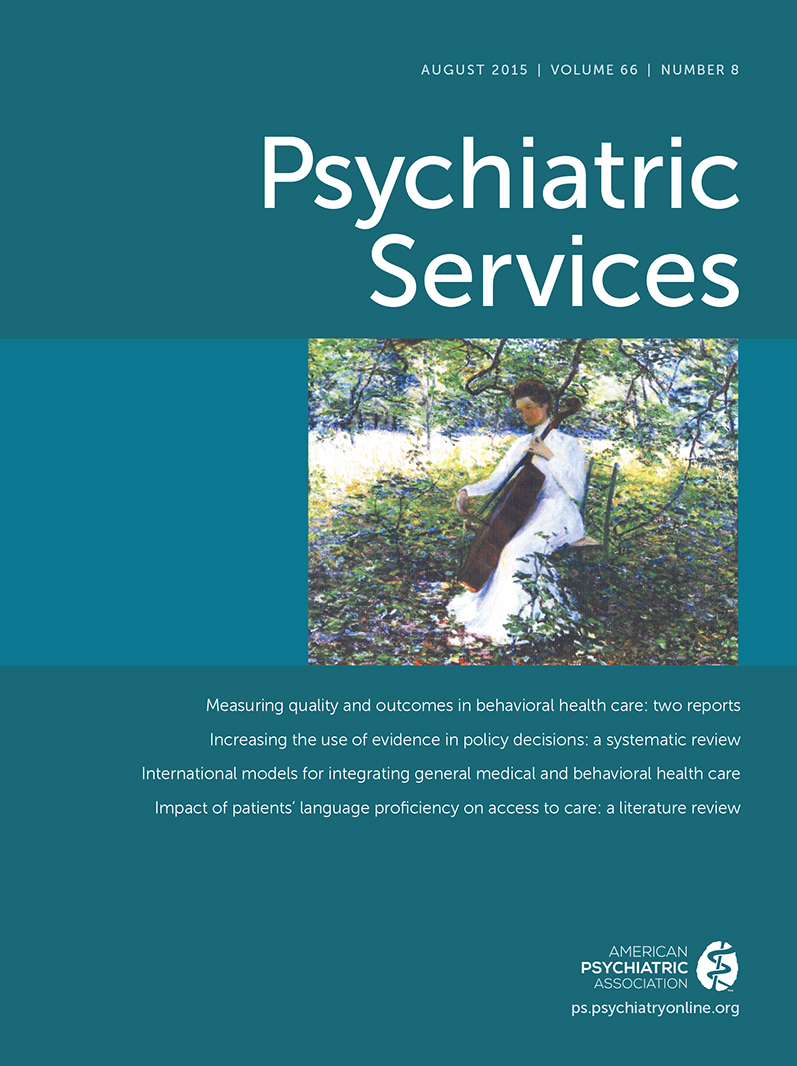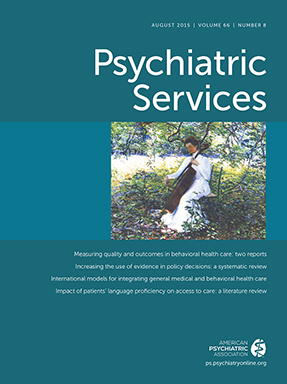In many states, reduced availability of inpatient psychiatric beds has significantly changed the psychiatric emergency department experience (
1). For patients requiring psychiatric admission, extended boarding in emergency departments has become a common practice (
2). Compounding this dilemma, an increasing proportion of patients present to emergency departments with psychiatric chief complaints, and those who present with psychiatric complaints are more likely than medical-surgical patients to require hospital admission (
3). Inpatient bed availability in North Carolina has been particularly affected by reductions in state and general hospital psychiatric beds (
1), although many U.S. states are struggling with similar severe bed shortages, as well as shortages of psychiatrists. Given this growing crisis, the interplay between training experience and career choice is increasingly important.
Unfortunately, the increasingly fraught condition of the psychiatric emergency department may deter current and future residents from continuing to serve high-need populations posttraining. For instance, in relevant work on burnout—a psychological condition characterized by emotional exhaustion, depersonalization, and a diminished sense of personal accomplishment among service providers (
4)—physicians reporting the least control and the greatest imbalance between expected and experienced stress also exhibit the highest levels of burnout (
5). Burnout has been identified as a significant factor in job satisfaction and work performance among training physicians in the United States (
6). Although psychiatrists report lower levels of burnout than other medical subspecialties, emergency medicine has the highest burnout rate of any medical subspecialty, suggesting a vulnerability to burnout among those at the “front lines of access to care” (
7).
A connection between serving low-resource populations and subsequent burnout has been identified. Physicians serving in areas with increased poverty rates show decreased career satisfaction, and psychiatrists working in practices taking new Medicaid patients have shown decreased career satisfaction relative to peers (
5,
8).
Burnout also plays an important role in future career planning. Residents who experience burnout in their first year of training are likely to continue to do so throughout training (
9). This is particularly salient in assessing the continued interest of medical trainees in work in resource-poor settings.
We report on a survey undertaken to characterize psychiatry trainee experiences in emergency departments across North Carolina in the wake of statewide reductions in mental health funding and in inpatient psychiatric hospital beds—including the recent loss of half of all state hospital psychiatric beds (
1). Counties where the residents’ primary teaching hospitals are located had high proportions of behavioral health Medicaid patients in the emergency department in fiscal year 2013, ranging from 13% in Orange County (location of University of North Carolina at Chapel Hill) to 35% in Forsyth County (location of Wake Forest Baptist Health System) (
10). This study sought to clarify multiple dimensions of resident experiences, including quality of care provided to emergency department patients, quality of teaching and supervision, burnout, mental health policy opinions, and career intentions. The objectives of the study were to describe the emergency department experiences of psychiatry residents in North Carolina, explore relationships between emergency department experiences and burnout, and identify predictors of resident plans to care for publicly funded—specifically Medicaid—patients.
Methods
All 177 psychiatry trainees across the four residency programs in North Carolina (Duke University, the University of North Carolina at Chapel Hill, East Carolina University, and Wake Forest University) were invited by e-mail to complete an anonymous online survey through Qualtrics survey software. The study was exempted from review by the Duke University Medical Center Institutional Review Board. Participation was encouraged by a raffle for a tablet computer at the end of the survey. The survey was opened November 6, 2013, and closed December 2, 2013. The survey explored resident experiences in emergency psychiatry, attitudes toward patient care, burnout, attitudes toward mental health policy, and future career plans. Ninety-one residents (51%) completed the survey. Burnout was measured via two items abstracted from the Maslach Burnout Inventory (MBI) (
11). Two items—“I feel burned out from my work” and “I feel more callous towards people since I took this job”—have been validated as a brief burnout assessment tool with psychometric properties comparable to those of the full MBI (
12). Residents were asked to rate the frequency with which they agreed with both statements during their rotation in the emergency department. Ratings were on a 5-point Likert scale ranging from 0, never, to 4, multiple times per shift. Burnout scores were assessed both as a sum representing a total burnout score and separately as discrete domains. Plans to accept Medicaid patients in the future, as a proxy for willingness to treat publicly insured patients, were measured by asking respondents, “Do you see yourself accepting Medicaid patients when you enter clinical practice?”
Bivariate analyses of demographic variables and emergency department experiences and burnout were completed initially. Next, adjusted models of burnout and intentions to serve publicly funded patients were conducted. Statistical significance was set at an alpha level of .05. Statistical analyses were conducted with IBM SPSS, version 22.
Results
Of the 91 respondents, 82 (90%) had completed an emergency psychiatry rotation. Most participants were white (65%, N=59) and female (59%, N=54), and most were under age 30 (68%, N=62). Most respondents (77%, N=70) had attended U.S. medical schools, and most had more than $100,000 in educational debt (63%, N=57). [Demographic data are available in a table in an online supplement to this report.]
A large majority of respondents (95%) who had worked in the emergency department had worked some nights, and 42% had worked alone on their most recent shift (
Table 1). Experiences with violence and assault were not uncommon among residents: eight out of 82 respondents (10%) had been assaulted while working in the emergency department, and 29 residents (32%) had been assaulted at some point during their residency. Twenty-one percent of residents rated their safety in the emergency department as fair or poor.
According to bivariate analyses, graduates of non-U.S. medical schools were significantly less likely than U.S. medical graduates to report feelings of callousness (corresponding to the depersonalization domain of the MBI). Exhaustion and difficulty with patient disposition were significantly associated with all domains of burnout. Compared with other residents, residents who rated the quality of care that they provided as fair or poor had higher burnout scores. Those who found patient care responsibilities too much to manage at least once per shift had significantly higher emotional exhaustion and composite burnout scores. High perceived quality of supervision from the attending physician was associated with lower burnout scores, whereas feeling that one was providing care of fair or poor quality was significantly associated with higher burnout scores. Burnout was not associated with year of residency or with time since last emergency psychiatry rotation.
Overall, 54% (N=45) of residents anticipated accepting Medicaid patients after residency. In bivariate analysis, no demographic factors were associated with Medicaid acceptance. Frequent discouragement about patient length of stay in the emergency department, assault in the emergency department, and burnout were all associated with plans to avoid treating Medicaid patients after training. In particular, having been assaulted in the emergency department was negatively associated with planned Medicaid acceptance (odds ratio=.09, p<.05). As the level of burnout increased (by tertile), the likelihood of accepting Medicaid patients diminished. [A figure in the online supplement provides more detail.] Bivariate analyses were confirmed by multivariate regression analyses (not shown).
Discussion
Burnout has long been accepted as a significant factor in job satisfaction and employee retention. Our findings suggest that psychiatry resident burnout in the stressful environment of the emergency department is significantly associated with long-term plans to care for publicly insured patients—a serious concern given the growing shortage of psychiatrists across the United States.
In resident physicians’ descriptions of their experiences, perceived exhaustion emerged as a major factor associated with both dimensions of burnout assessed—emotional exhaustion and the perception of oneself as callous. It is reassuring that the perception of working with a “very good” or “excellent” attending physician was significantly associated with a lower burnout score. Although it is possible that residents experiencing burnout were more likely than other residents to find fault with supervisors, previous research suggests that burnout is not a significant predictor of resident assessment of attending physicians (
13) and that overly directive supervision and lack of autonomy may diminish trainee satisfaction. Notably, more direct attending psychiatrist participation in emergency department patient care has been associated with reductions in patient length of stay (
14).
The experiential correlates of burnout versus plans to work with Medicaid patients were quite different. Whereas exhaustion, overwhelming patient care duties, and suboptimal attending supervision were significantly associated with burnout, being assaulted and feeling discouraged by patient length of stay were associated with a lower likelihood of plans to work with publicly insured patients. Being assaulted or feeling upset by the length of time that patients board in the emergency department (for lack of beds), not resident burnout, appeared to most affect residents’ desire to work with Medicaid patients.
To our knowledge this study was the first to associate burnout with the future practice plans of psychiatry residents. The negative association between burnout in the emergency department and future intention to care for Medicaid patients suggests that this work environment may prejudice trainees against caring for publicly insured patients in the future. Given the overall shortage of psychiatrists nationally and the particular shortage of psychiatrists willing to care for Medicaid patients, this finding suggests the importance of offering high-quality training environments as an opportunity to increase the number of psychiatrists available for these vulnerable populations. In addition, the Affordable Care Act relies heavily on Medicaid expansion to ensure improved access to mental health care providers (
15). This study suggests that negative training experiences may exacerbate psychiatric workforce shortages in caring for the newly publicly insured.
Our study had numerous limitations. First, because of the cross-sectional nature of the data set and absence of baseline data, causality cannot be ascribed. Residents who were disinterested in accepting Medicaid patients may have been more likely to get burned out, rather than vice versa. Second, the abbreviated MBI was easy for participants to complete but may have elicited responses different from what the full inventory would have elicited, and the results could not be dichotomized, leaving burnout as a relative concept. As such, one might expect the abbreviated measure to be less sensitive than the full MBI with a dichotomous burnout outcome, attenuating these findings. In addition, although validated (
12), the abbreviated measure was not subject to the rigorous psychometric evaluation of the full MBI. Although the response rate was 51%, the population surveyed was small, and therefore the study may have been underpowered to identify important associations between either burnout and demographic factors or burnout and experiential factors. There were no data on the perceptions and expectations of residents who chose not to participate.
Conclusions
Resident emergency department patient care experiences, including difficulties with overwhelming patient care duties, exhaustion, and attending supervision, influenced residents’ feelings of burnout and callousness. Resident burnout appears to be associated with less inclination to care for publicly insured patients in the future. Emergency department experiences in psychiatry residency training may play an important role in shaping residents’ conception of their future clinical practice.

